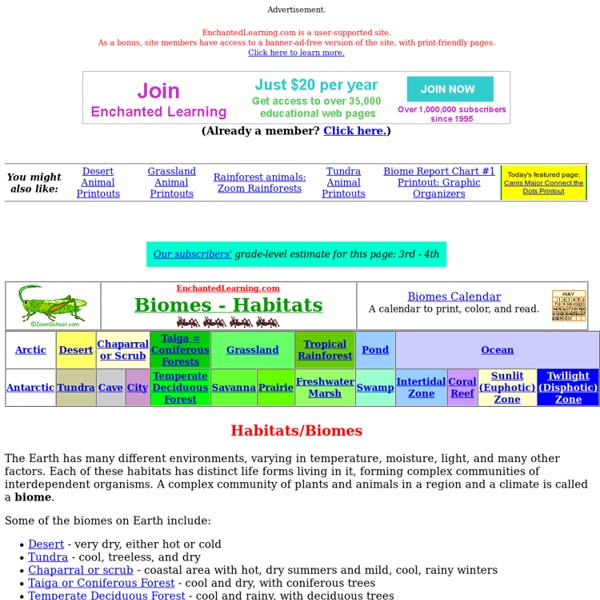



Earth Exploration Toolbook Awarded Science Magazine's Science Prize for Online Resources in Education (SPORE), September 30, 2011 AAAS Press Release What is the Earth Exploration Toolbook? Developed by teams of scientists and educators, the Earth Exploration Toolbook (EET) is a collection of online Earth system science activities. Each activity, or chapter, introduces one or more scientific data sets and analysis tools that enables users to explore some aspect of the Earth system. Within the context of a case study, each chapter guides users through a step-by-step process in which they access data and use analysis tools to explore real issues and questions in Earth system science. Who is it for? Earth Exploration Toolbook chapters are written to the teacher, generally at the secondary and college level. How can I learn more? Come on into the site!
Math and Telling Time This page is one small part of Good Sites for Kids! All the mathematics sites have been given their own pages. Please click on the matrix below to go there. Look for to see what's been added lately! "We now have over 4,000 PDF files that total over 12,000 printable pages. 100% free as always! Free Worksheets for Kids from K-5 Learning. Mastering these worksheets would give students a solid foundation to build on. Math Worksheet Center "What is Math Worksheet Center? to top of page to Good Sites Powered by The World's #1 Web Host I'm gnawing away at Mathematics! Habitats game ABPI - Resources for Schools "The skin quiz is a web page I will refer my students to as a quick review of the subject." - Teacher View page Human and animal habitats Page 2 of 3 Habitats game Do you know where each animal should live? Find out in the Habitats Game This activity is based around a series of questions relating to the suitability of particular habitats for animals. Many of the questions can be used to provide opportunities for class or group discussion based on the suitability of environments and how animals are adapted to fit these environments. Section Contents Map The Association of the British Pharmaceutical Industry 7th floor, Southside, 105 Victoria Street, London, SW1E 6QT Telephone +44 (0) 870 890 4333 ABPI Cymru Wales ABPI Northern Ireland ABPI Scotland Terms and conditions Cookie & Privacy policy Accessibility statement Site map This website uses essential cookies without which it will not work, along with other harmless cookies aimed at improving your use of our website.
What's globalisation got to do with me? | Global Education Learning areas English Year 9 Analyse how the construction and interpretation of texts, including media texts, can be influenced by cultural perspectives and other texts (ACELY1739) Interpret, analyse and evaluate how different perspectives of issue, event, situation, individuals or groups are constructed to serve specific purposes in texts (ACELY1742) Create imaginative, informative and persuasive texts that present a point of view and advance or illustrate arguments, including texts that integrate visual, print and/or audio features (ACELY1746) Year 10 Analyse and evaluate how people, cultures, places, events, objects and concepts are represented in texts, including media texts, through language, structural and/or visual choices (ACELY1749) Identify and explore the purposes and effects of different text structures and language features of spoken texts, and use this knowledge to create purposeful texts that inform, persuade and engage (ACELY1750) Geography General capabilities Extension
Breathingearth - CO2, birth & death rates by country, simulated real-time News Literacy: How to Teach Students to Search Smart Credit: Quickhoney The word simple can rarely be used when it comes to describing online searches for news and information. Type a noun and a refining adjective into a search engine, and you're presented with an indefinite number of links (hence, perhaps, the word Google). The information can seem equally useful at first glance but will inevitably vary wildly in accuracy, from a New York Times article to a deadpan spoof in the Onion to a biased political blog filled with misinformation. Alan C. Visiting journalists pose four questions to students: Why does news matter? In response, students in the program create projects that answer these questions. Though it's a remarkable resource, the sheer abundance of online information has its downsides. Everyone has to learn to think like a journalist, Miller says, but "most students today don't have the tools to navigate through the forest of sources available of widely varying purpose, accountability, and reliability." Learn to Spot Bias
FETCH! . Games . Draw That Habitat Be sure to log in to send Ruff your drawings. Not a member? Join now! What to Do: Use the drawing tool to draw a habitat for this month's challenge. When your drawing is done you can send it to Ruff or save it for yourself. If you send your drawing to Ruff, he will show it to our habitats expert who will pick 12 drawings for the gallery. In the Gallery, you can rate drawings based on how well the habitat provides food, water, shelter, and space for the animal that lives there. The drawing tool requires the Flash 9 plugin.
Teachers Homepage - National Geographic Education This website would like to remind you: Your browser (Firefox 17) is out of date. Update your browser for more security, comfort and the best experience on this site. Educators! Take our survey for a chance to win a $50 Amazon gift card. Xpeditions is now archived in National Geographic Education's new website—natgeoed.org If you liked Xpeditions, you'll love the new media-rich natgeoed.org. www.natgeoed.org Please note: to search for Xpeditions content, check the “include archive” filter. National Geographic Education Twitter Facebook Google+ Email Quiz Connection! Most Popular Latest Videos Giant Traveling Maps Get great resources for introducing geography and map-reading skills to students in Grades K-8.